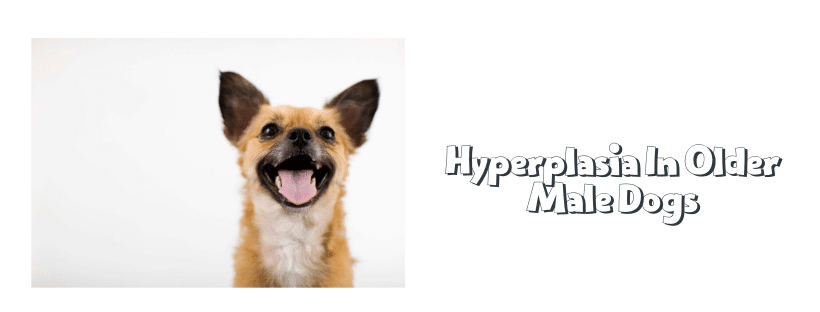Hyperplasia In Older Male Dogs
Hyperplasia of the prostate gland is a benign enlargement due to an increase in the number of cells within the gland and occurs in about 2/3 of older male dogs. However, only a small percentage of these dogs ever show any noticeable signs of the abnormality. The underlying cause is unknown but is thought to be an imbalance of the hormones produced in aging testicles. As the prostate is located directly below the rectum, the enlarged gland may press up against the rectal wall and cause difficulty and discomfort while defecating, straining, and constipation. Unlike man, there is rarely any pain or difficulty in urinating.
Medical treatment with an estrogen injection generally stops the symptoms, reduces the size of the prostate within five or six days, and will keep it that way for several months, in most cases, and occasionally for several years. Some few dogs respond poorly, or not at all, and can be helped only by castration, which causes a permanent shrinking of the prostate.
Should your dog need this operation, he will be home from the hospital in just a few days, but you should keep him quiet and resting for at least one week. A low-bulk diet may be advised for several days. He will probably walk cautiously at first, experiencing some slight discomfort each time he moves a rear leg. This may prompt him to lick or bite at the stitches. Restraint collars or tranquilizers may be used for a short time until the operation is healed and the stitches can be removed.
Cancer of the prostate is rare in dogs and fortunately so because, by the time any noticeable symptoms develop, the tumor has almost always spread to other parts of the body, making it inoperable. Severe loss of weight, lameness in one or both rear legs, pain and difficulty during urination, blood at the beginning of urination, and low back pain may be present in addition to difficult defecation and constipation. Castration or estrogen therapy offers temporary relief of symptoms, but the tumor continues on its destructive course. A recent discovery holds out hope that immunotherapy may be successfully used to treat prostatic cancer but such research is still in its infancy.
Question and Answer about the dog on general: Part 5
Is the surgical risk greater in the older dog? Usually yes, again depending upon the status of the heart and the kidneys. All of this should be thoroughly checked out before the older dog is anesthetized. The anesthesia provides a greater risk than surgery. If the dog is competently evaluated before surgery, there should only be a one-percent risk factor of anesthetic death. During the time when sodium pentobarbital was more widely used for anesthesia, many dogs never woke up because of a condition called acidosis. Over-dosing caused excess absorption of the pentobarbital into the body. Just when you would think the dog was nicely asleep, his fat began to release it, thereby effecting an overdose in the dog. When sodium pentobarbital is in the bloodstream, there is no control or reversal. Today, with gas anesthesia, the risk is almost zero because of the greater control the vet has.
Do dogs get arthritis as they get older? Some do. Larger dogs are more prone to arthritis because of hip dysplasia, and because of the proclivity to hip dysplasia, they also get arthritis in the hip joints. But dogs don’t have to be old to get arthritis. Small dogs are less prone to arthritis, regardless of their age. The general correlation does not preclude the existence of one condition without the other; however, the two usually do go together.
Do older dogs need more sleep? They probably rest more, but this indicates a lessening of physical activity rather than excessive sleeping.
Do older dogs eat less? Growing dogs eat twice as much as those no longer growing, but, once they attain adulthood, they generally stabilize their eating habits. However, a sick dog, no matter what his age, will generally stop eating altogether. Older dogs will tend to eat less.
Can an older dog be hurt by using a metal choke chain to train him, or even just to walk him? Metal chain collars are perfectly safe as long as the dog is in good physical condition. Nylon choke collars provide an alternative.
How often do dogs get heart attacks? Dogs don’t get heart attacks as they manifest themselves in humans. If a dog gets a heart block, related to arterial obstruction, he can drop dead but it wouldn’t be a heart attack. However, dogs do get strokes, which would indicate an obstruction leading to the brain. A heart attack is not a veterinary term.
What is the most common cause of death in dogs? Cars kill more dogs than all other causes combined, more than all diseases. Irresponsible dog owners are the real killers, the cars are merely the means of execution. Among diseases, kidney and heart diseases take an equal toll, and cancer is a more common cause of death nowadays than heretofore. Let us repeat here what was stated earlier. There must be respect for community leash laws. Dogs should not walk themselves. Always take your dog for his walks, whether to answer a call of nature or just for a stroll, on the leash. We, the dog owners, have that responsibility to our pets; their safety and longevity depend on us.


